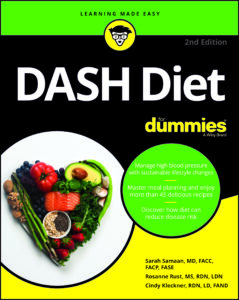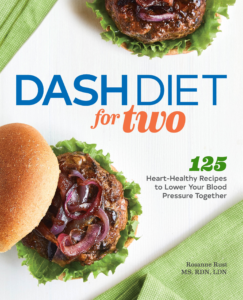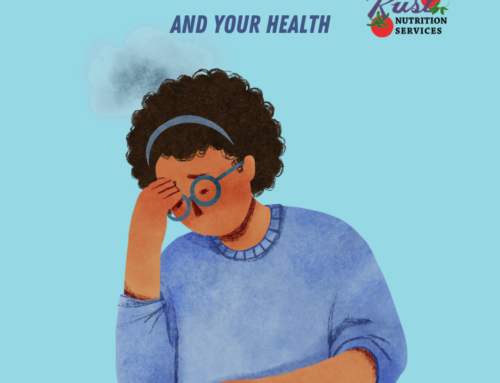Have you ever made an excuse for why you can’t choose healthy foods to eat? I often get questions about whether DASH is difficult or too expensive to maintain. In my opinion, as long as you set small goals, it’s not difficult. You can choose expensive foods, but you can also choose affordable ones. The beauty of DASH, and other healthy dietary patterns like the Mediterranean diet, is that there are lots of food choices that can be included.
My goal is to continue to help people understand what the DASH Diet is, and how to set goals to adopt it. As always, my advice is to set small goals, and build on them to create healthy, long-term habits. For instance, maybe a drastic sodium reduction isn’t for you, but you feel you can totally add more fruits and vegetables into you diet. Great!
The goal is to adopt a healthy lifestyle. This means continuously setting goals each week to eat well and exercise. Click To TweetIt’s never an all-or-nothing deal, and you don’t have to be an overnight-success. Nobody can be perfect every day.

A simple bowl of whole grain, low sugar cereal along with fruit and milk, can be included in an economical DASH diet plan.
Affordability, Access, or Choice?
People have a lot of excuses for why they don’t adopt a healthy diet. Some people may not have access to some food components of a DASH or Mediterranean diet (fruits, vegetables, nuts, olive oil). While this is the case in some geographic areas, many people who do have access to markets , have transportation, and could indeed follow the diet plan. However, they simply choose not to.
The notion that it’s too expensive doesn’t fly with me. You don’t have to eat avocados or nuts everyday, or the most expensive cuts of meat. There is no requirement for designer food. You can buy the vegetables that are on sale or in season, and for BOGO fruits (buy one, get one half off or free). Canned beans are very inexpensive and fit into the DASH plan. Choosing store-brand barley, brown rice, canned fruit, or yogurt, all fit the bill. You can buy frozen vegetables and items that are on sale. There are lots of economical options.
See Chapter 12, DASHing Successfully through the Grocery Store and chapter 24 Ten Tips for Following DASH on a BudgetDASH Diet For Dummies® 2nd ed
Patients also can reframe their view that “DASH foods” are expensive and instead view them as an “investment” in their health. For instance, nuts are expensive; but you are only supposed to eat about 1/4 cup serving a few times a week, so they can last a while (and guess what? If you don’t love nuts, you don’t have to include them). In the long run, fruits and vegetables are not more expensive than junk food or convenience food (the foods you’ll need to cut back on). Meats are to be consumed in smaller portions (3-6 ounces), so you can spend less, and stretch the portion out for four people.
Myth: DASH Diet is just for old people
DASH was developed to treat high blood pressure with diet. However, it is definitely not just for older people with high blood pressure.
High blood pressure, formerly a mid-life disease, is also diagnosed (or under-diagnosed) in younger people. DASH can benefit people of all ages because it's simply a healthy eating pattern. Click To Tweet That’s why US News & World Report ranked it as #1 Best Diet for Healthy Eating.
In addition, new research has shown that DASH can help people with arthritis or gout, and pregnant women. Researchers recently examined if adherence to the DASH diet during pregnancy results in a lower risk of gestational hypertensive disorders (high blood pressure during pregnancy). The study questioned 3,414 Dutch women about adherence to DASH. The better they adhered to the the diet, the lower their risk for high blood pressure and complications.
Next Step: Proper Health Education and Follow-Up
For the most part, nutrition education should begin in the doctor’s office. I’d love to see more primary care physicians go a step further in promoting the Mediterranean or DASH Diet as an option for “how to eat well”. It’s not enough to say “Well, you should try the DASH Diet or the Mediterranean Diet.” If a patient has no idea what that means, then the “advice” is useless.
Whether the direction to “follow the DASH Diet” comes with a simple one-pager, a book referral, or a referral to a registered dietitian for counseling, there must be a “next step”.


You’d think we’d have this figured out by now. It’s a pet peeve: Physicians telling their patients to “go on a diet”, “lose weight.” Or “try the DASH Diet” without any further instruction or support. When I worked in a health center, one of my favorite things to do was clean out the “nutrition education” file drawer that the doctors and their nurses kept. The handouts filed there were generally outdated, and unappealing. It would not surprise me if there are still health centers with faded and outdated “diet sheets” in a drawer somewhere!
Most people need the extra step of seeing a registered dietitian for nutrition coaching. Registered dietitians guide their patients in the first steps of adopting a new eating plan. A dietitian can help you create a DASH plan based on your own food preferences and food budget.
- Find a dietitian that you like in your area
- Make an appointment. The dietitian will evaluate your current eating, lifestyle habits, and medical history. He or she will provide you with a plan, help you set some goals and likely offer some material to take home for review.
- It may only take a two or three visits to get you on track.
Cheers to healthy eating, no matter what your age or income level.





[…] labels matter to a lot of folks, and yet not a lot has changed about what sort of diet is actually good for you. Consumers are often led to choose foods based on the claims on the label, or even the style of the […]
People don’t follow the DASH diet because the meal plans put out by NIH (https://www.nhlbi.nih.gov/health-topics/dash-eating-plan) are unrealistic and often ridiculous. There are a lot of recommendation for things like low fat cheese and low fat cottage cheese. These are things that do not taste like their high fat counterparts. Furthermore they actively taste bad. Similarly Whole wheat pasta which is heavily recommended, is difficult to cook and doesn’t taste “right”. That and the hilariously minuscule amounts of protein in the plans makes them laughable. Also the massive amount of fiber in the diet can lead to gastro -intestinal distress in people not used to whole grains. In short the DASH diet is a laboratory experiment that does not consider how real human beings live.
DASH Diet does include low fat dairy, but some high fat dairy can be incorporated. There is no reason to use only whole wheat pasta – if you don’t like it, don’t use it. I personally prefer regular pasta and choose whole wheat versions of breads and cereals, and other grains (like barley or farro) instead. The protein content of the diet is adequate, and it’s not a “laboratory experiment” but evidence based to lower blood pressure. The most important components are increased fruits and vegetables and lower sodium intake.